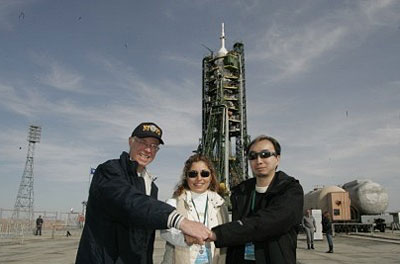Can space tourism really change the space industry?by Taylor Dinerman
|
| The price of a ticket to orbit will only come down when there is a reason for it to do so, i.e. the need to compete. |
Most people are also aware that what is only available for the very rich today will be on sale at affordable prices a bit later. This was particularly true of tourism, where once upon a time a ride across the ocean in a jet plane was something people actually got dressed up for. Potential customers find it easy to imagine that one day, relatively soon, they too will be able to follow Dennis Tito and the others into space. Who knows: in ten or twenty years time maybe the ISS will be a privately-owned historic structure, where people go to see where the space tourism business began. Sort of like the Ritz Hotel in Paris.
For the moment the price of a ticket to obit is determined by the fact that the Russians have a monopoly. The US is not going to sell tickets on the few remaining shuttle flights and the Chinese are a long way from being able to offer a trip to paying customers. The price of a ticket to orbit will only come down when there is a reason for it to do so, i.e. the need to compete.
The industry has a long way to go to get there. The problem is still the cost of access to orbit. Some in the space industry believe that NASA’s COTS (Commercial Orbital Transportation Services) will eventually lead to a second path for space tourists in get into orbit. Others are more or less skeptical, since NASA’s track record on commercialization is not very good. Mike Griffin seems more committed to COTS and to the entrepreneurial space sector than previous administrators, but unless he can profoundly reform the system COTS may not survive his tenure.
At least one US government source says that the choice of Elon Musk’s SpaceX as one of the two winners was a “no brainer”. The Falcon 9 vehicle, along with the Dragon capsule, may be ready in time for a 2011 unmanned launch carrying pressurized cargo to the ISS. This would depend on many factors, including the successful launch of Falcon 1 sometime within the next six or seven months as well as a smooth appropriations process. If Congress is able to give SpaceX some running room they may in fact succeed where so many others have tried and failed.
| If Musk and his management team at SpaceX are successful in this part of their effort, they may be setting an example for the industry as a whole. It may be that twenty years from now the space industry will be peopled by SpaceX alumni. |
One aspect of SpaceX that has not gotten much attention is their effort to develop a youthful and highly skilled blue-collar workforce. This is a critical issue for the space industry as a whole. Over the last ten or fifteen years many observers have warned that the skills needed to build the next generation of space vehicles are held by a set of older—and soon to retire—men and women who joined the industry in the 1960s and early 1970s.
If Musk and his management team at SpaceX are successful in this part of their effort, they may be setting an example for the industry as a whole. Some of today’s workers at SpaceX may go on to engineering school or earn themselves graduate degrees in science. It may be that twenty years from now the space industry will be peopled by SpaceX alumni.
There has been some debate at whether space tourism has reached the tipping point. This may not be the right question to ask. Already Space Adventures and their Russian partners have broken though the profitability barrier. However, a single venture does not make an industry, but the potential for some combination of SpaceX and Bigelow’s space hotel project to match the Space Adventures/Russia/International Space Station combination is becoming more realistic every day.
The suborbital aspect of the industry has not yet achieved even minimal profitability. When it does it will be a useful gateway to the “real thing”. Today potential Space Adventures customers who don’t want to shell out the full $20-million price tag can test themselves by taking a Mach 3 ride in a MiG-25. Virgin Galactic customers likewise may be dipping their toes into the world of personal spaceflight. Ten years from now it will be interesting to look back and see who was synergistic with whom.
